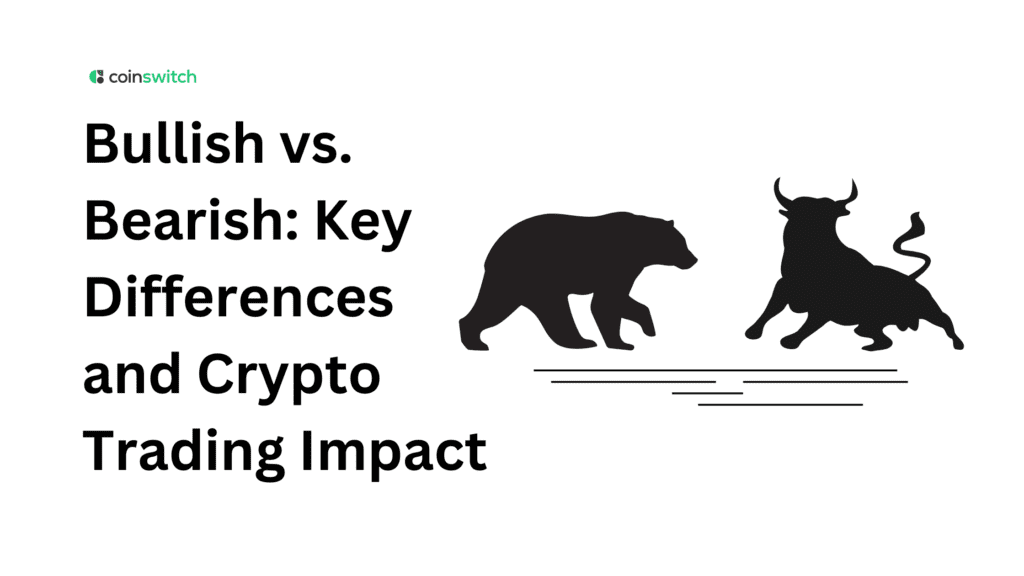Bull and Bear Markets
Ever wondered why traders use animals to describe market moods? Probably, it refers to the manner in which bulls and bears typically behave when they attack: a bull thrusts its horns upward, while a bear swipes its paws downward. These animal movements are widely accepted as a means of gauging market sentiment. When asset prices rise, you’re looking at a bullish trend. When they slide, the mood shifts to bearish.
These two terms shape everything in trading. If you are interested in Bitcoin, altcoins, or meme tokens, it’s essential to have a clear understanding of the distinction between bullish and bearish trends. This can help you time your moves and identify the right entry and exit points.
If you are new to crypto and struggling to find your footing, this blog post can help you out. We will explain how these cycles impact the overall market sentiments and how you can read the signs before everyone else does.
So, let’s break it all down, one move at a time.
What’s the Difference?
The primary difference between bullish and bearish markets lies in their direction and behavior. A bullish market is characterized by energy and optimism. On the contrary, the bearish market slows down the momentum and alters investment and trading decisions. Both matter because they define how traders experience the market every single day.
In a bullish market:
Prices rise steadily or sharply
Charts keep climbing. Each new breakout feels like fresh air, pulling more traders in. Momentum builds fast, and the pace excites everyone watching.
- Investor confidence increases
- Optimism spreads across portfolios. Traders hold their assets longer, convinced that the next leg higher is around the corner. Confidence turns into conviction.
- Demand outpaces supply
- Buyers dominate order books. Coins get picked up faster than sellers can list them. That pressure alone drives prices higher and sustains the rally.
- Trading volume often surges.
- Exchanges light up with activity. Big names like ETH, SOL, and DOGE lead rallies. Breakouts, trend following, and dollar-cost averaging shape the action.
- In a bearish market:
- Prices keep declining
- Candles slope lower day after day. Sellers stay in control, and the mood shifts to caution.
- Sentiment turns cautious
- Excitement fades. Traders watch closely, paying more attention to stability than upside.
- Selling pressure builds up.
- More positions unwind. Portfolios slim down as exits accumulate, and liquidity shifts toward safer ground.
- Panic or profit booking kicks in.
- Some exit quickly. Others rotate into stablecoins or stabler assets, aiming for balance and patience.
Both bullish and bearish phases reflect the natural rhythm of the crypto market, or any other market for that matter. They shape energy, guide conversations, and remind traders that every move carries its own story.
It’s important to note that traders and investors stand to benefit when they are aware of bullish vs bearish market conditions. The reason is that these conditions help track trends and manage a long-term portfolio.
Read More: What is Momentum Trading?
Identifying Market Conditions
Are you trying to figure out if the market is bullish or bearish? These signals should help you read the trend before it makes headlines:
Price Trends
When charts show rising highs and higher lows over several sessions, traders recognize a bullish structure. It reflects strong buying interest, consistent demand, and momentum that holds. Each pullback finds support, and new resistance levels break easily, keeping the trend active.
Volume Spikes
Trading volume adds weight to price action. During a bullish run, volume typically increases as more traders enter the market. Heavy activity confirms market conviction. In fast corrections or shakeouts, volume also spikes, often as large players move funds or take profits.
Moving Averages
Short-term averages crossing above longer-term ones are one of the most commonly used signs by traders. Traders consider this fresh bullish energy. Let’s say the 20-day line crosses the 50-day or 200-day line. This could be a potential bullish signal.
Fear & Greed Index
This index tracks market sentiment using data from multiple sources. The index reading ranges from 0 to 100. A lower value indicates extreme fear, and a higher value signals extreme greed.
RSI (Relative Strength Index)
RSI is a metric that can be used to track the speed and size of recent price moves. For instance, an RSI reading of 70 or above indicates an overbought condition. A reading of 30 or below indicates an oversold condition.
Tracking these signals builds confidence. Over time, you learn to read the room and move with the market, not against it.
External Factors and Market Impact
Market momentum doesn’t just come from charts and indicators. External events often steer the mood across the crypto market. Whether you’re spotting a bullish phase or bracing for a bearish stage, these forces shape what happens next.
Regulatory Shifts
When governments pass pro-crypto regulations or introduce investor-friendly tax policies, traders usually respond fast. A fresh approval or green light often sparks a bullish reaction across coins. Projects feel validated. Exchanges expand services. On the flip side, restrictions can cool enthusiasm. Markets pause as traders adjust positions based on the policy tone.
Macroeconomic Events
Global finance has a significant impact on digital assets. Moves such as interest rate hikes, inflation data releases, or economic growth signals send clear ripples in the crypto market. Bitcoin and Ethereum often respond directly to announcements from central banks like the Fed. When inflation slows or rate cuts happen, the mood turns bullish. During uncertain periods, markets tend to be cautious.
Exchange News
Crypto exchanges can also impact trader confidence. A high-profile listing on platforms like Coinbase or Binance often leads to strong bullish interest in the asset. Visibility increases, new buyers step in, and volume surges. On the other hand, exchange hacks or similar events can erode investor confidence and may drive them to exchanges deemed safer, creating a bearish mood.
Institutional Moves
Large-scale investments/buys from funds like BlackRock or companies like MicroStrategy often kickstart bullish cycles in crypto. These moves attract headlines and bring validation to the asset class. When whales—large holders of crypto—start buying, the crowd usually follows. When those same entities move capital around or rebalance portfolios, the action often shapes short-term sentiment.
Social Media and Hype
Online buzz can drive investor behavior. A single tweet from a known influencer, a viral Reddit thread, or a trending topic on X can flip sentiment instantly. Positive chatter often fuels bullish rallies. Token mentions, launch updates, or airdrops quickly grab attention and spark trades.
Traders who stay alert to these signals respond smarter, before the charts catch up.
Read More: Scalping Strategies: Mastering Profit Making in the Market
Navigate Bull vs. Bear Markets
Here’s how traders handle bullish vs bearish conditions differently:
In Bullish Markets:
- Hold longer: Confidence stays high, so short-term volatility doesn’t shake holders.
- Use breakout entries: Traders jump in as resistance breaks and the price takes off.
- Set trailing stop-losses: To lock gains without missing more upside.
- Increase position sizing: Gradually add to winners during strong uptrends.
In Bearish Markets:
- Switch to stablecoins: Preserve capital during corrections or crashes.
- Use short-selling strategies: Advanced traders profit from falling prices via futures.
- Set tighter stops: Protect against sharp drops and fakeouts.
- Focus on fundamentals: Research-led investing often outlasts emotion-led exits.
Knowing how to pivot is the difference between surviving and thriving.
Investor Mistakes in Bull and Bear Markets
Market conditions change fast, and that’s when small missteps turn into missed opportunities. Across bullish vs bearish cycles, certain patterns show up often, especially when emotions push traders harder than logic.
Chasing Hype in Bull Runs
As coins rally and feeds fill with green charts, the energy pulls everyone in. Price moves fast, influencers start celebrating, and late entries crowd in. By the time many traders react, the earlier momentum shifts direction. The move already played out, but attention still lingers on the high.
Ignoring Exit Signals
In a bullish market, confidence grows fast. As assets rise, the urge to stay in becomes stronger. Signs of exhaustion or reversals often get overlooked. Traders ride the wave longer than planned, watching strong gains turn into flat performance or stalled moves.
Panic Selling in Bear Markets
Red candles trigger strong emotional responses. As prices dip, portfolios shrink quickly. Many trades close not from signals but from pressure. The speed of a drop feels louder than the calm of recovery, and that shift drives reactions. Traders leave their positions and wait without a set plan.
Overtrading
Volatility invites more entries, especially in markets without a clear direction. Every small bounce or drop feels like a moment to capture. Traders chase setups across multiple timeframes, filling charts with entries that rarely align with structure. Activity stays high, but clarity fades with each trade.
Forgetting the Bigger Picture
In both bullish and bearish phases, screen time increases. Focus narrows to intraday moves and quick headlines. The larger cycle, weeks or months, slips out of view. Short-term noise takes center stage, even when the trend already tells the story.
Market mistakes often follow behavior, not strategy. Recognizing those patterns helps traders read the mood with sharper focus.
Take Control of Your Crypto
Understanding bullish vs bearish trends helps you stay calm and in control. You’ll stop reacting to noise and start trusting your own analysis.
Start by:
- Tracking crypto news daily
- Using simple technical tools like moving averages and RSI
- Watching volume and sentiment indexes
- Setting realistic entry and exit points
- Staying consistent, even if the market mood swings
Knowing the market mood boosts your decision-making. It’s how confident traders protect capital and capture upside.
Every smart move starts with reading the room right.
FAQs
1. Is bullish or bearish better?
Each has its own benefits. Bullish markets offer gains, while bearish trends give entry points and opportunities to reassess.
2. What is the difference between bullish and bearish in crypto?
A bullish trend means prices rise, demand increases, and confidence builds. In a bearish trend, prices drop, sellers dominate, and sentiment weakens.
3. Is bullish buy or sell?
During a bullish phase, traders typically look to buy and ride the upward momentum.
4. Which is better, the bear or the bull market?
Both are strong market trends. Bullish markets help investors build wealth, while bearish ones reset prices, offering fresh opportunities to build positions.








